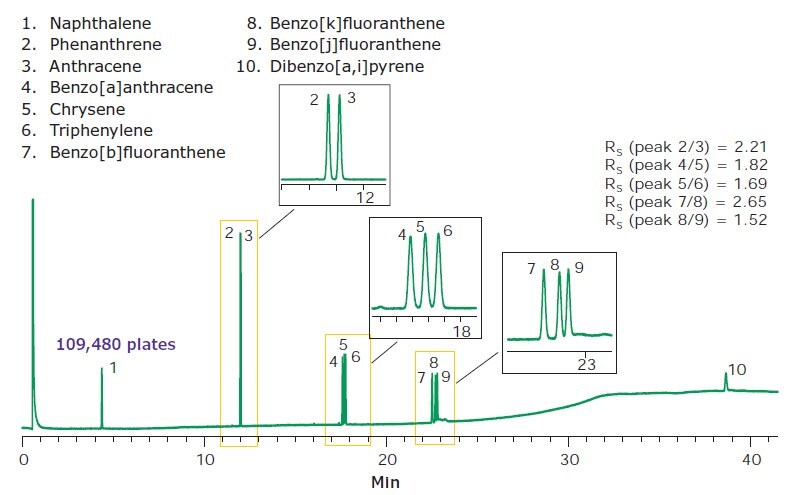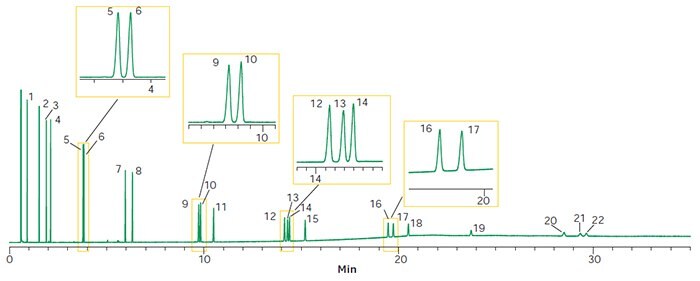Achieve Exceptional Resolution of PAHs, Including Several Isomer Sets Using SLB®-ILPAH Capillary GC Columns
Lisa McCombie1, Len Sidisky2
1Product Manager GC, 2R&D Manager Gas Chromatography
Polycyclic aromatic hydrocarbons (PAHs) are ubiquitous in the environment. They belong to a group known as persistent organic pollutants (POPs). Monitoring is important because they are identified as carcinogens. Multiple isomers exist, which are difficult to resolve chromatographically. SLB®-ILPAH is a special purpose column based on an ionic liquid stationary phase. A distinct combination of stationary phase selectivity and efficient column dimensions allow exceptional resolution of PAHs, including several isomer sets. Complete column specifications are listed in Table 1.
Conditions |
|---|
Resolution Test
Every SLB®-ILPAH column is specialty tested to ensure it meets stringent resolution requirements for several sets of PAHs. Figure 1 depicts a chromatogram obtained from analysis of the QC test mix. The resolution (RS)
results obtained from this chromatogram are:
- 2.21 for phenanthrene/anthracene
- 1.82 for benzo[a]anthracene/chrysene
- 1.69 for chrysene/triphenylene
- 2.65 for benzo[b]fluoranthene/benzo[k]fluoranthene
- 1.52 for benzo[k]fluoranthene/benzo[j]fluoranthene
Column efficiency is also determined by measuring the theoretical plate value of naphthalene. For this chromatogram, it was good, based on the value of 109,480 plates that was obtained.

Figure 1.QC Test Mix
22-Component PAH Mix
Multiple regulatory agencies around the world have promulgated methodologies for the analysis of PAHs. The number of analytes listed in these methods ranges from 16 to 24. To present data more accurately aligned with real-world usage, a 22-component PAH mix which contains the most frequently listed PAHs was analyzed on a SLB®-ILPAH column. The resulting chromatogram is shown in Figure 2. The significant finding is that this column has the necessary selectivity to provide exceptional resolution for several sets of PAHs, such as peaks 5/6, peaks 9/10, and peaks 12/13/14. Also of great interest is that this column can provide baseline separation of dibenz[a,h]anthracene (peak 16) and indeno[1,2,3-cd]perylene (peak 17). This last pair typically co-elutes on other columns, and requires the use of mass spectrometry (MS) for proper identification.
Conditions |
|---|
1. Naphthalene
2. Acenaphthene
3. Acenaphthalene
4. Fluorene
5. Phenanthrene
6. Anthracene
7. Fluoranthene
8. Pyrene
9. Benzo[a]anthracene
10. Chrysene
11. 5-Methylchrysene
12. Benzo[b]fluoranthene
13. Benzo[k]fluoranthene
14. Benzo[j]fluoranthene
15. Benzo[a]pyrene
16. Dibenz[a,h]anthracene
17. Indeno[1,2,3-cd]pyrene
18. Benzo[g,h,i]perylene
19. Dibenzo[a,l]pyrene
20. Dibenzo[a,e]pyrene
21. Dibenzo[a,i]pyrene
22. Dibenzo[a,h]pyrene

Figure 2.22-Component PAH Mix
Conclusion
The main strength of ionic liquid GC columns is unique selectivity. This often results in increased resolution compared to columns made with polysiloxane polymer or polyethylene glycol columns. The analysis of PAHs is an example of how an ionic liquid column can achieve a level of separation not possible with other columns. In this case, it is the specially tested
SLB®-ILPAH.
Multiple applications, product information, real-time availability, and ordering information is available 24 hours a day
We offer a wide variety of single-component and multi-component PAH mixtures available as certified reference materials (CRMs). Additionally, we have great custom capabilities.
To continue reading please sign in or create an account.
Don't Have An Account?